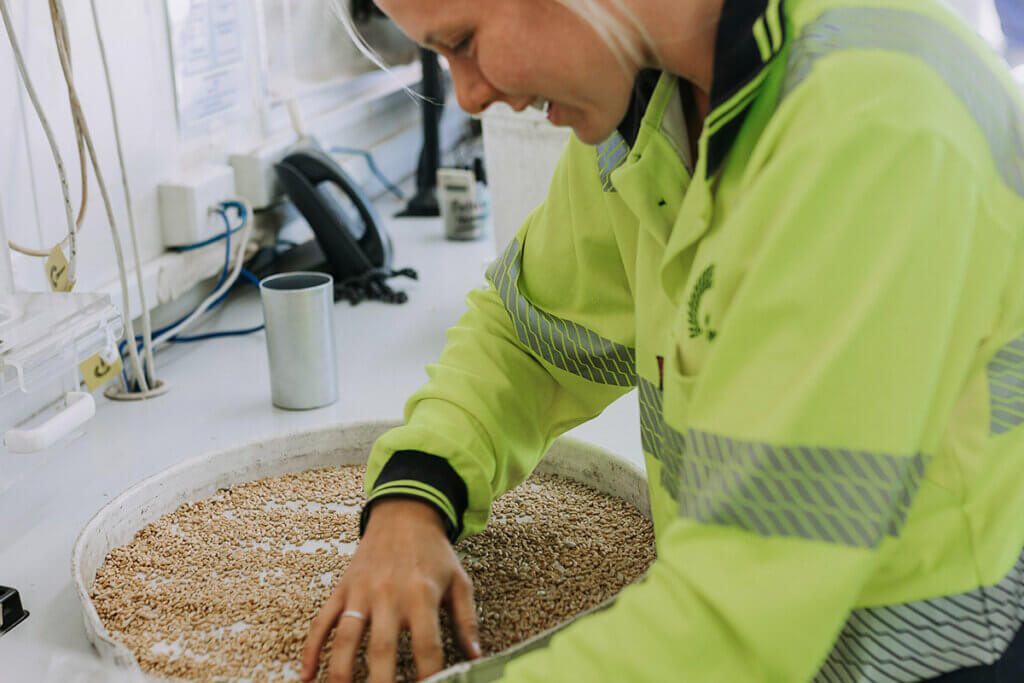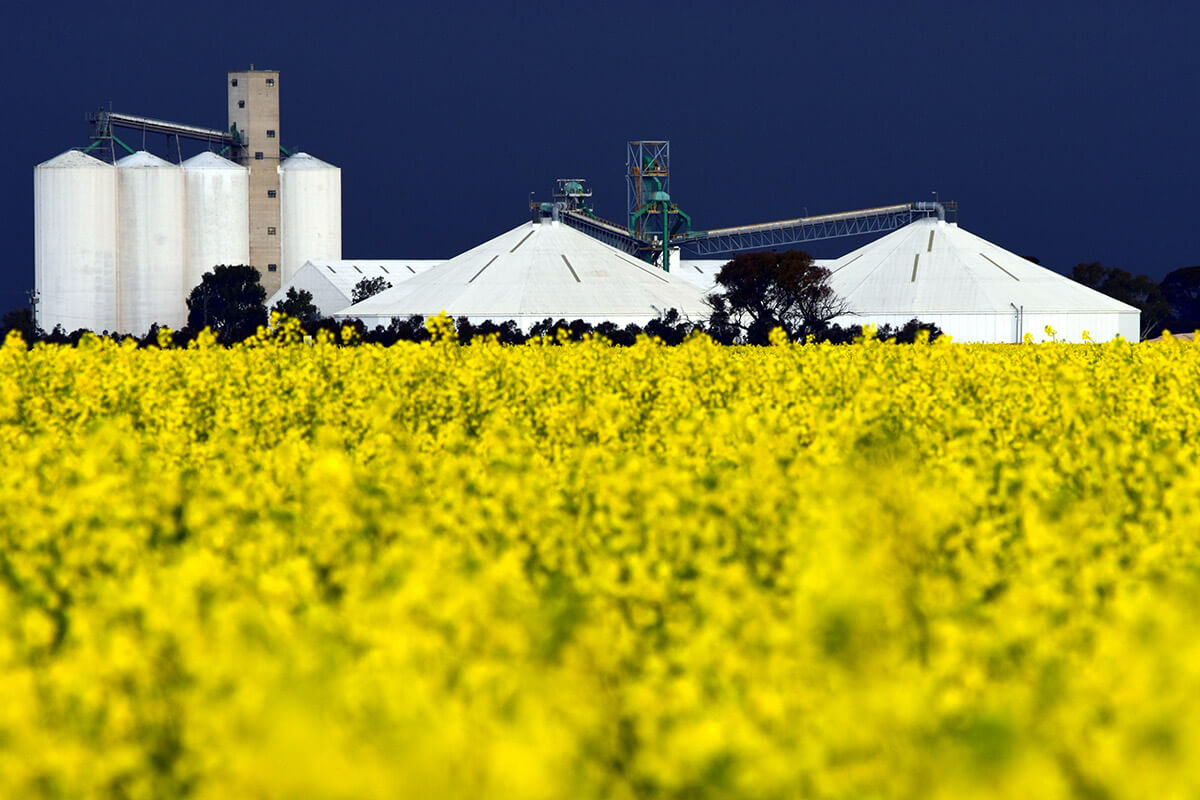CBH Group
Australia’s largest co-operative and a major national asset
CBH fast facts (July 2020)
- Established: 1933 in Western Australia
- Turnover: $4.2 billion
- Member businesses: 3,900
Co-operative Bulk Handling (CBH Group) was formed in 1933 and is Australia’s largest co-operative and the nation’s largest grain exporter. It is also a leader in the Australian grain industry, with operations now extending across on farm inputs, grain storage, handling, transport, marketing and processing.
CBH Group has total assets of more than $2 billion[1], employing around 1,100 permanent employees and up to 1,800 casual employees during the harvest period.
The WA grain industry is the largest agricultural sector in the state and the fourth largest export industry overall. CBH’s grower members produce an average of 14.4 million tonnes of grain annually, about 40-50 per cent of the entire Australian grain production depending on the season, and contributing almost $4 billion to the state’s economy each year.
Co-operative Conversations
Watch Jimmy Wilson, CBH Group CEO, who was a member of the expert discussion panel on Co-operative Conversations Episode 1. Hosted by renowned agricultural journalist Pete Lewis, the candid conversation begins with co-op leaders, agricultural experts and primary producers from Australia and overseas debating and discussing the future of farming and if the co-operative model could be an option to future proof our home-grown agribusinesses.
Watch this in-depth interview with Natalie Browning, CBH Group Deputy Chair, discussing how farmers can take some of the risk out of agricultural production by co-operating in business together, on Co-operative Conversations Episode 5.
[1] Unless otherwise specified, all figures throughout are in $AU


CBH case study, CEMI Discussion Paper series
Despite its success, CBH has had to face pressure from both external and internal forces to demutualise.
The extended version of this case study is presented in Australia’s Leading Co-operative and Mutual Enterprises in 2016, which is part of the CEMI Discussion Paper series.
Structure of the Australian grains industry
The grain industry is one of Australia’s oldest and largest agribusiness sectors. Grain growing commenced with the first European settlement in 1788 and today there are around 11,922 grain growers in Australia producing a variety of crops that include wheat, coarse grains, oilseeds, and legumes.
Australian grain producers are predominately family owned farms that employ small, usually casual and seasonal, workforces. To remain competitive grain producers must have access to suitable land and enjoy growing conditions such as appropriate levels of rainfall at the right time of the year. They need to invest in state of the art production systems such as precision farming and the adoption of the latest technologies and crop varieties. There is also an increasing need for more economies of scale, with fewer producers now owning and operating larger farms.
The supply chain for grain in Australia is dominated by a small number of large firms that undertake bulk grain handling and storage, as well as grain wholesaling. Grain wholesaling is a $16.5 billion industry that has enjoyed an annual growth rate of 4.2% over the past five years. There are around 363 firms operating in this sector, but five companies control about 62% of the market. The two largest by market share are Glencore Grain Pty Ltd and the CBH Group.
Bulk grain storage, handling and wholesaling
There are at least 116 bulk grain storage and handling businesses operating in Australia. However, once again the same five companies dominate the market. CBH is the most significant player followed closely by GrainCorp. The others are Cargill Australia, Glencore Grain, and Emerald Grain.
Of these five firms, only CBH is a co-operative. By comparison, GrainCorp is a publicly listed Australian company employing over 3,088 people with annual revenues of more than $4.1 billion and assets of $3.7 billion (IBISWorld, 2015). The other firms are foreign owned subsidiaries of companies.
The competitive success of these major agribusinesses is their ability to offer efficient, integrated services that encompass both bulk grain handling and storage, as well as grain wholesaling and trading. CBH Group has a good balance of both functions and is a fully integrated business that receives and stores around 90% of the WA grain harvest and has recently expanded into other states.
The evolution of the CBH Group
Founded in 1933, CBH is a non-distributing co-operative owned by its 4,200 members who are independent grain growers located in Western Australia. The company operates its own fleet of railway locomotives and rolling stock for bulk grain transport. With 1,200 employees it is one of the largest employers in the state.
For much of its history CBH operated under the Bulk Grain Handling Act (1936) that granted it the exclusive right to handle bulk wheat in WA. This drove the company to expand so that it could provide grain handling and receival points wherever farmers who had sufficient grain to supply were located. In the 1950s the co-operative widened its operations to include oats and barley, with a strong focus on building up export markets.
The deregulation of the grains industry that took place in the 1980s led to the loss of the firm’s exclusive right over bulk wheat handling. Despite this, CBH continued to grow and in 2002 it merged with the Grain Pool of WA to widen from handling and storage, to wholesaling and marketing. By 2004 it had entered into a joint venture with the Salim Group to operate our mills in Asia. In the following year it formed a joint venture with the Hudson Shipping Lines to operate United Bulk Carriers and then Australian Bulk Stevedoring in 2009. It acquired online grain price comparison services DailyGrain the following year and in 2015, CBH acquired the oat milling business, Blue Lake Milling Pty Ltd.
Threats to CBH’s mutuality
Despite its success, CBH has had to face pressure from both external and internal forces to demutualise. In 2000 a minority group of members, with the backing of third-party interests sought to demutualise the co-operative. More recently, CBH has experienced a challenge from a minority group of members known as Australian Grain Champions (AGC).
With the backing of GrainCorp and former directors, AGC sought to have CBH demutualised and listed on the Australian Stock Exchange (ASX). This saw the co-operative engage in an education and consultation program with its members, exploring the possible options for the co-operative’s business model. In September 2016, the AGC-GrainCorp group formally withdrew their bid in the face of a rejection by the board and membership of CBH to their proposed change to the firm’s co-operative status.
CBH is governed by a board of 12 directors, of which 9 are grower members and 3 are independent directors selected on the basis of their expertise. According to the directors of CBH the recent demutualisation campaign led by AGC caused the co-operative to enter into a major review of its purpose and member value proposition.
According to Newman the experience of the demutualisation of the South Australian Co-operative Bulk Handling (SACBH) in the early 2000s provided a good case study. Founded in 1954, SACBH had around 17,365 members by the end of the 1990s, but demutualised to form a hybrid grower-owned business known as AusBulk-United Grower Holdings (UGH). By 2004 AusBulk-UGH had merged with the Australian Barley Board (ABB) and became a publicly listed company known as ABB Grain Ltd. At its height ABB Grain had around 16,300 members, employed over 1,100 people and managed over 4 million tonnes of storage capacity. However, by 2009 it had been acquired by the Canadian company Viterra only to be taken over by Glencore Grain in 2012. In each case a relatively few investors made good returns to their share capital, but the growers lost control and ownership.
In many ways the AGC-GrainCorp bid offered the CBH board another opportunity to better explain the benefits of the co-operative business model and compare it against a range of alternative business models including full demutualisation and public listing. The recent experience of CBH responding to the AGC-GrainCorp demutualisation bid also highlights the importance of CMEs in fully understanding their purpose and using this to help remind their members of the role that they play and the benefits that mutuality can offer.
The “keystone” role of CBH Group
CBH is not only Australia’s largest co-operative by annual turnover, it is also one of the most significant agribusiness firms in the nation and a major player in the grains industry. In 2014/15 CBH contributed around $2.98 billion to the WA state economy. It invested about $1.2 billion into capital projects and it has been estimated that its 4,200 grower members accounted for 25% of the total economic activity of the WA agricultural sector.
CBH also undertakes a range of community and social benefit programs. This includes spending $1.5 million on sport and recreation, health, safety and the arts via its Community Investment Program. It spent $880 million on upgrading road and rail transport systems across the 300,000 square kilometre wheat growing areas of the state, that also benefit local communities. A further $600,000 was donated by the co-operative over the previous four years to charitable organisations such as the Royal Flying Doctor Service, the WA Country Football League, Ronald MacDonald House, Hockey WA and Musicavia (Deloitte Touche Tohmatsu, 2016).
Since its emergence in the depths of the Great Depression, the CBH Group has played a “keystone” role in keeping the WA grains industry competitive. This “keystone” role occurs where a large firm becomes the centre of a wider network or “business ecosystem” and uses its power to help keep the system vibrant and healthy. It may, as in the case of CBH, provide the smaller “niche” firms such as the grain producers, the opportunity to secure access to supply chain infrastructure, services and support that might otherwise be unavailable to them at a competitive cost. Large CMEs such as CBH help to protect the smaller “niche” members and enable them to survive and remain sustainable. They also protect these smaller firms from “dominator” firms that typically come from overseas to take over the entire industry and reduce competition, often forcing the smaller “niche” firms to become price takers.
CBH has survived another significant challenge to its mutuality and the board and its membership have had an opportunity to assess the costs and benefits of the co-operative business model. The final decision to remain a co-operative keeps CBH as a major player within the Australian grains industry with no other purpose than to work for the benefit of its members.



